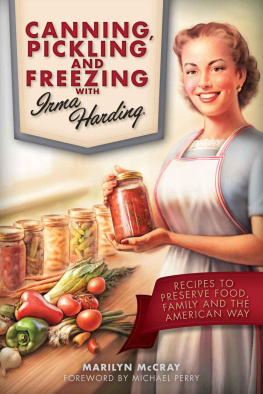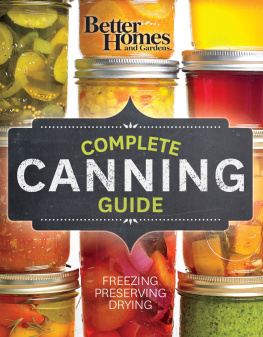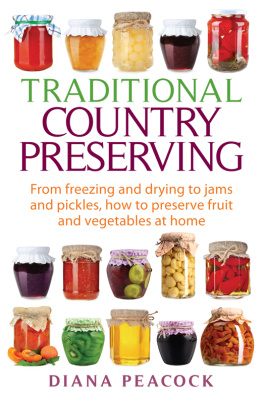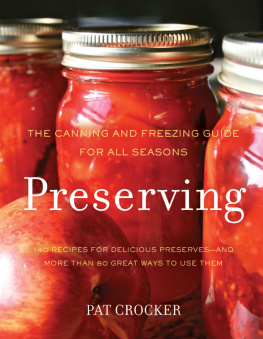Copyright 2015 by Meredith Corporation, Des Moines, Iowa.
All rights reserved.
For information about permission to reproduce selections from this book, write to Permissions, Houghton Mifflin Harcourt Publishing Company, 215 Park Avenue South, New York, New York 10003
Library of Congress Cataloging-in-Publication Data is available.
Complete Canning Guide.
pages cm.
Includes index.
ISBN 978-0-544-45433-0 (hbk);
ISBN 978-0-544-45365-4 (ebk)
Book design by Waterbury Publications, Inc., Des Moines, Iowa.
Ebook design by Rebecca Springer
Better Homes and Gardens Complete Canning Guide
Editor: Jan Miller
Contributing Project Editor: Mary Williams, Waterbury Publications, Inc.
Contributing Writer: Lisa Kingsley, Waterbury Publications, Inc.
Contributing Copy Editors: Terri Fredrickson, Gretchen Kauffman
Art Director, Photography: Ken Carlson, Waterbury Publications, Inc.
Test Kitchen Director: Lynn Blanchard
Test Kitchen Product Supervisor: Colleen Weeden
Contributing Photographers: Karla Conrad, Jason Donnelly, Jacob Fox, Andy Lyons
Contributing Stylists: Jennifer Peterson, Charlie Worthington
Administrative Assistants: Barb Allen, Ann Schill, Marlene Todd
Special Interest Media
Editorial Director, Food: Jennifer Dorland Darling
Art Director: Gene Rauch
Houghton Mifflin Harcourt
Publisher: Natalie Chapman
Editorial Director: Cindy Kitchel
Executive Editor: Anne Ficklen
Editorial Associate: Molly Aronica
Managing Editors: Marina Padakis Lowry, Rebecca Springer
Production Director: Tom Hyland
Design Director: Ken Carlson, Waterbury Publications, Inc.
Associate Design Director: Doug Samuelson, Waterbury Publications, Inc.
Production Assistant: Mindy Samuelson, Waterbury Publications, Inc.
Our seal assures you that every recipe in Better Homes and Gardens Complete Canning Guide has been tested in the Better Homes and Gardens Test Kitchen. This means that each recipe is practical and reliable and meets our high standards of taste appeal. We guarantee your satisfaction with this book for as long as you own it.
SUMMER IN A JAR
Whether you grow your own fruits and vegetables, are a dedicated patron of your local farmers market, a member of a CSA, or simply want to capture the best peak-season produce at the lowest prices in the supermarket, there are so many good reasons to can your own food.
FLAVOR. Few things brighten the beginning of a cold day in March more than toast slathered with jam made in June from perfectly ripe strawberries. A bowl of made from peak-season tomatoes, corn, green beans, and carrots put up in July warms body and soul.
HEALTHFULNESS. When you can your own food, you control virtually every aspect of what goes into it. Protect the nutritional integrity of fruits and vegetables and tailor your home-canned products to suit your taste and lifestyle. They can be all-natural or organic, with minimal sugar, salt, or fat and no preservatives. In addition to recipes for canning, this book also contains recipes for freezing, drying, and fermentingall ways of preserving that put you in control of your food and how its prepared.
ECONOMY. Canning your own food is a great way to save money on the grocery billsespecially if you grow your own produce. After the initial outlay for equipment, each gorgeous jar of food costs just pennies. Great abundance is created with very little in terms of dollars.
EMOTIONAL SATISFACTION. Not only do you know there are months of good eating at your fingertips, but it is also deeply rewarding to put up your own food. Canning and preserving allows you to move through the year with quality fruits and vegetables on your pantry shelves.
Whether you are an experienced canner or have never so much as snapped a bean, Better Homes and Gardens Complete Canning Guide provides all the information and inspiration you need to stock your pantry with home-canned food using both the boiling-water and pressure canning methods. This book offers the safest, simplest, and most up-to-date methods to ensure success, and there is something for every taste and occasion.
Get the water boiling and get canning!
ACIDITY
BOILING-WATER CANNING
INGREDIENTS
JARS
PRESSURE CANNING
PRODUCE
TOOLS AND UTENSILS
TROUBLESHOOTING
THE FIVE RULES OF CANNING
LEARN THE BASICS OF FOOD PRESERVING FOR A SAFE AND DELICIOUS EXPERIENCE.
Follow these basic rules to ensure success.
1. KNOW WHICH CANNER TO USE The boiling-water cannerbasically a big pot with a lid and a rack in the bottomis used for high-acid foods, which naturally resist bacteria growth. Pressure canners are used with low-acid foods and recipes that are prone to harboring harmful microorganisms. They heat food hotter than boiling-water canners. Recipes specify which type of canner to use. (See for more information.)
2. CHOOSE THE RIGHT JARS Use jars made specifically for canning. Dont use glass jars from purchased food, even if they look like canning jars. Dont use jars that look different from the canning jars currently on the market. And avoid jars with chipped edges; that can affect the seal. Use the size jar specified in the recipe because it takes longer to achieve the critical internal temperature in larger jars. (See for more information.)
3. USE LIDS PROPERLY Use the special two-piece lids manufactured for canning. Reuse the rings, but do not reuse the lids, which have a special sticky compound that seals the jar. Dont screw lids on too tightly or they wont create a vacuum seal. Heat the lids in very hot but not boiling water or the compound wont seal (check the manufacturers directions for preparing lids). Test for sealing on each jar after it has cooled. Press the center of the lid. If the button is depressed and does not make a popping sound, it has sealed properly. Remove and clean the rings before storing canned food. (See for more information.)

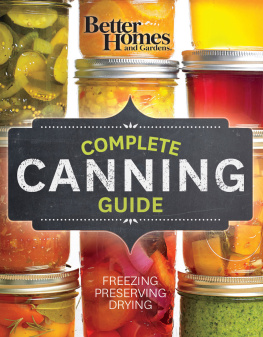




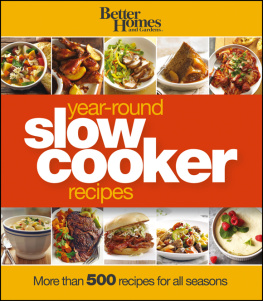
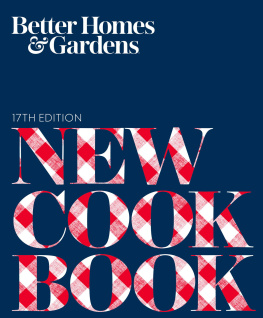

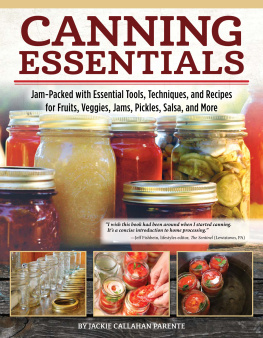
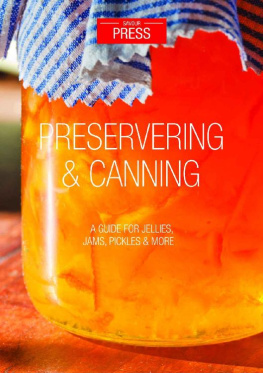
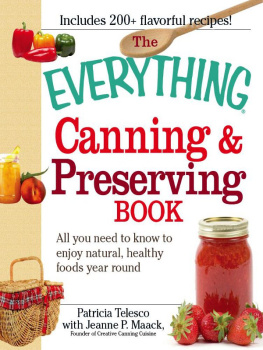
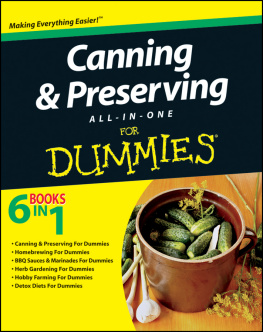
![Better Homes - Better homes and gardens you can can: [a guide to canning, preserving, and pickling]](/uploads/posts/book/188232/thumbs/better-homes-better-homes-and-gardens-you-can.jpg)
